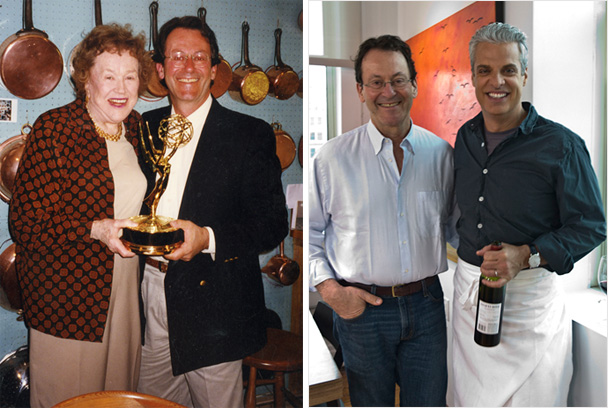Turn on the TV, and chances are you’ll stumble on a cooking show with just a click or two. Director Geoffrey Drummond has nurtured TV chefs from the days of Julia Child to today’s on-screen cookfest. Along the way he’s adapted to the changes in both technology and the public’s appetite for cooking programming. As always, his latest project is on the cutting edge: cooking on an even smaller screen—the iPad.
Gourmet Live: Your shows with Julia Child helped cooking to become a true TV phenomenon. What was she like to work with? Do you think Dan Aykroyd’s impression of her had a kernel of verisimilitude?
Geoffrey Drummond: Working with Julia was a joy and an inspiration. It was an amazing collaboration during which I learned so much from her, and not just about cooking and eating but about commitment, focus, and integrity in what you do and how you do it.
When I first started working with Julia, she made it absolutely clear to me that it was her name on the show, her name on the book, and that meant that she was going to be 100 percent involved with what was said and shown, including the way the show was produced (collegial, collaborative, congenial). The final product had to be something she was going to be proud to serve to her audience, no different from the roast chicken she would bring out to her dinner guests.
Julia did not think of herself as an entertainer; she was a teacher with a mission, and we all know what that was. But she was a great teacher, because she was an entertainer. She was smart, funny, and knew her stuff—deep down. She held to her core values, and never shied away from announcing them—often with a little twinkle of a smile, acknowledging that she might just be tweaking some raw nerves with the “food police.”
The Dan Aykroyd SNL piece really captured Julia’s drive and commitment to food and cooking, and did it with great humor as well as nuance. Julia and Paul [her husband] loved the piece. And, as well as being great comedy, it certified Julia’s status not so much as “The French Chef” but as “America’s Chef.” And it simultaneously introduced the idea, if not the term, “celebrity chef,” introducing her to an audience that went well beyond her PBS cooking fans, who already knew and loved her. In later years, Julia was the one who introduced many of America’s future celebrity chefs to television. From Alice Waters and Lidia Bastianich to Emeril Lagasse and Rick Bayless, In Julia’s Kitchen with Master Chefs introduced the best of two new generations of top chefs to a soon-to-be demographic called “foodies.”
GL: You’ve worked with so many renowned chefs since you started A La Carte Communications in 1990, such as Jacques Pépin, Lidia Bastianich, and Michael Chiarello. Any funny stories from shooting these food shows?
GD: Yes, one of the terrific benefits of producing and directing food shows is you get to learn how to cook, and you get to be the first to eat and drink what’s been cooked and poured. Working at Lidia Bastianich’s house in the early days of doing her show, there was a real family feel, and that’s because there was always Lidia’s real family on the set. Lidia’s mother, Erminia, was a constant presence (I called her the executive executive producer), along with Giovanni, Erminia’s live-in boyfriend; Lidia’s [then] husband, Felice; and often Lidia’s son and daughter, Joe and Tanya, as well. Over the years, grandchildren were added to the gallery.
As we set up cameras and lights in the morning, Lidia would be making Felice breakfast before going into makeup, and Giovanni would be engaging anybody who stopped working for a minute to discuss the upcoming Italian soccer league matches. Crew lunches were always in the backyard, again a famiglia. And I do remember a time when Lidia, knowing that I was an ardent fan of grappa, offered a tasting of her homemade infused grappa. Eliat, our video engineer, who could not say “no” to a taste of anything, went a bit overboard, not so much drinking the grappa, but eating the fruit that had spent most of its life soaking in grappa. We were—but should not have been—surprised to find Eliat fast asleep, head embossed by the myriad switches and knobs on the control board, and the video of our food looking nothing like what Lidia was cooking in the kitchen.
Julia and Jacques had a fabulous relationship; she adored and respected him but sometimes treated him as she would a brother, just wanting to get a bit under his skin. She would often switch planned ingredients at the last minute, knowing that it would upset Jacques’ sense of order, but also knowing that he was a master at handling what he came to call Cuisine Impromptu. On one show, Jacques was supposed to bone out a chicken; Julia switched it (planned by her, of course, and kept from Jacques) at the last minute to a turkey—much more dramatic-looking—and said, “Jacques, you are a great boner. Well, let’s see you bone this!”
GL: Why do you think TV is such a good medium for food, even though you can’t smell or taste the final product?
GD: It’s great storytelling structure. Cooking, eating: beginning, middle, and end. Nature and nurture. It’s of primal interest—it is totally natural to be interested in food. It is also nurtured, from childhood. As babies, we sit in the kitchen watching our food being cooked. We come together as family at the dinner table. Food is the medium through which we court our mates, get to know our clients, and celebrate our holidays, anniversaries, and life passages. Or at least we should. And food is great common matter for people to talk about, to share experiences, stories, and know-how.



 Pinterest
Pinterest


